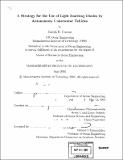| dc.contributor.advisor | Chryssostomos Chryssostomidis. | en_US |
| dc.contributor.author | Curran, Joseph R. (Joseph Robinson) | en_US |
| dc.contributor.other | Massachusetts Institute of Technology. Dept. of Ocean Engineering. | en_US |
| dc.date.accessioned | 2006-07-13T15:23:25Z | |
| dc.date.available | 2006-07-13T15:23:25Z | |
| dc.date.copyright | 2004 | en_US |
| dc.date.issued | 2004 | en_US |
| dc.identifier.uri | http://hdl.handle.net/1721.1/33426 | |
| dc.description | Thesis (S.M.)--Massachusetts Institute of Technology, Dept. of Ocean Engineering, 2004. | en_US |
| dc.description | Includes bibliographical references (leaves 167-169). | en_US |
| dc.description.abstract | Light Emitting Diode (LED) technology has advanced dramatically in a few short years. An expensive and difficult to manufacture LED array containing nearly 100 individual LEDs and measuring at least 5 cm² can now be replaced by a single 5 Watt LED smaller than a quarter. As the light output for a given package size continues to increase, doubling every two years, it is possible to consider using these new LEDs to improve existing lighting systems and to explore non-traditional methods of underwater photographic illumination. So, can these high-output LEDs be used for underwater illumination, under what circumstances are they a good choice, and what is the optimal way to deploy them for a given set of conditions? In this thesis I attempt to answer these questions. In this thesis, I tested these 5W LEDs in a number of conditions and orientations in order to simulate the lighting conditions experienced by autonomous underwater vehicles (AUVs) illuminating and imaging targets on the ocean floor. These LEDs were characterized and compared to existing lighting systems and methods. Their suitability for use both as vehicle-carried illumination and off-the-vehicle lighting packages was examined. | en_US |
| dc.description.abstract | (cont.) Finally, conclusions were drawn as to the effectiveness of the 5W LEDs for underwater illumination and a guideline for LED illumination is presented to help AUV researchers determine the optimal lighting package for use on their missions. | en_US |
| dc.description.statementofresponsibility | by Joseph R. Curran. | en_US |
| dc.format.extent | 169 leaves | en_US |
| dc.format.extent | 9101133 bytes | |
| dc.format.extent | 9108282 bytes | |
| dc.format.mimetype | application/pdf | |
| dc.format.mimetype | application/pdf | |
| dc.language.iso | eng | en_US |
| dc.publisher | Massachusetts Institute of Technology | en_US |
| dc.rights | M.I.T. theses are protected by copyright. They may be viewed from this source for any purpose, but reproduction or distribution in any format is prohibited without written permission. See provided URL for inquiries about permission. | en_US |
| dc.rights.uri | http://dspace.mit.edu/handle/1721.1/7582 | |
| dc.subject | Ocean Engineering. | en_US |
| dc.title | A strategy for the use of light emitting diodes by autonomous underwater vehicles | en_US |
| dc.title.alternative | Strategy for the use of LEDs by AUVs | en_US |
| dc.type | Thesis | en_US |
| dc.description.degree | S.M. | en_US |
| dc.contributor.department | Massachusetts Institute of Technology. Department of Ocean Engineering | |
| dc.identifier.oclc | 62867815 | en_US |
